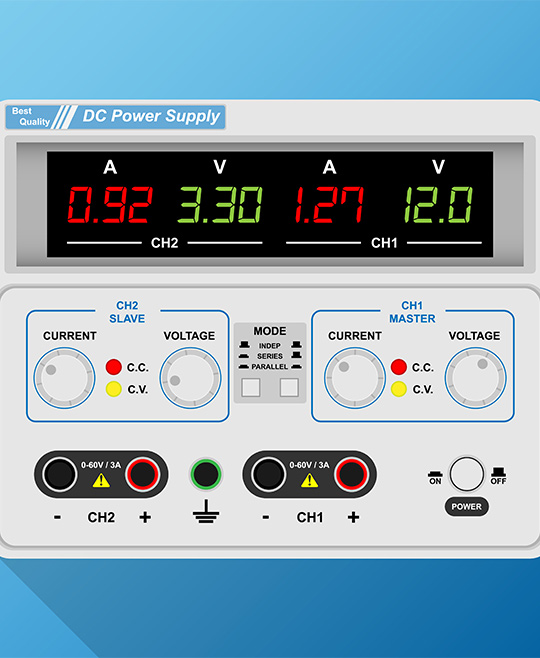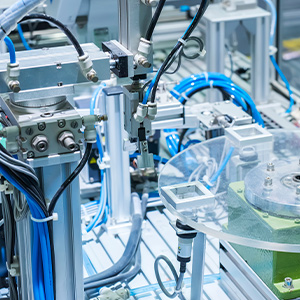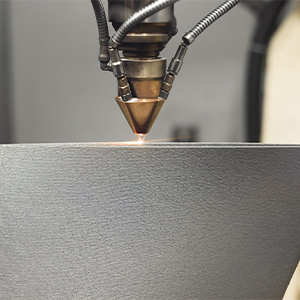What Is A DC Power Supply?
Post By: Tom Rowse On: 14-12-2022
When it comes to electricity, you have a choice between AC (alternating current) and DC (direct current). They’re both describing the direction in which the electrical current flows in a circuit. So DC describes a current that flows in only one direction, from the source directly to the device that demands the power. AC refers to electricity that can periodically change its direction, and which also introduces fluctuations in voltage.
AC power is the more commonly used current type for general supply, as it’s safer and can travel further. DC is more common in today’s electronically controlled circuits because it provides a constant, uninterrupted supply of current. It’s also essential for commercial production processes in order to keep them running smoothly.
DC power is easier to control and more accurate, but the most important thing is that it can be stored. Most commonly used electronic devices run on DC supplied from batteries. You might use AC power to charge them up, but it’s the DC power that runs the electronics. This is because they demand a constant, unvarying and uninterrupted supply of current which cannot be provided by the fluctuating AC. Electronic equipment relies on absolute precision, so even a slight variation in its input voltage may cause it to malfunction.
What Is A DC Power Supply?
A DC power supply converts AC power from a standard outlet into a stable DC power source. This regulated direct current is then used to power a device, module or component. DC power supplies come in varying levels of input and output voltage, output current and power rating. You can generally choose between a Constant Voltage (CV) model or a Constant Current (CC) model. In CV models, you set the output voltage you need from the power supply, and it’ll remain constant at that level even if changes occur in the load. In CC models, you set them to maintain a constant output current. Some DC power supplies offer both these options as alternative CV or CC modes of operation.
Input voltages are more commonly standardised over an available range, although it is also possible to specify just one power level. Output voltages are commonly offered for specific DC values of 5, 12, 24, or 48 volts. While you can get a DC power supply outside this output voltage set, this will limit your options. You’ll have a much wider range of standard supplies to choose from if you can match your system loads with one of the commonly-used voltages. If you can’t make your system work with the standard output voltage range, you have three possible options:
- Source a standard DC power supply offering the output voltage you need
- Find a vendor who’ll customise a DC power supply to provide your output voltage
- Create the necessary DC voltage using a DC-DC converter

How To Select A DC Power Supply
The most common factors you’ll consider when choosing a DC power supply are firstly its output range, and secondly its circuit method. While you might also consider how many channels it’s got or the accuracy and resolution of its settings, these two are the defining factors.
Output Range
DC power supplies may be a single-range system or one that offers a wide range of settings. A single-range power supply determines its output voltage and current by the voltage and current levels for which it’s rated. That means that if a stabilised DC power supply is rated for 80V and 10A of current at 800W, these levels will be the maximum that the power supply can achieve.
A DC power supply with wide or variable range determines its output current and voltage by its power consumption as well as its rated values. A variable-range DC power supply rated for 80V and 50A of current at 800W can only manage 10A of current output when operating at its maximum output of 80V. In these circumstances, power consumption will be under 800W. If you increase the output current to the maximum 50A, then the voltage output will be limited to a maximum 16V. The variable-range DC power supply doesn’t allow the combined maximum output of current and voltage that you can get with a single-range system.
Circuit Method
DC regulated power supplies work in two basic ways, on two types of circuits. These are called the switching method and the dropper or series dropper method, AKA the series [regulator] method, linear [regulator] method, etc.
The switching method converts the incoming AC current to DC, then reconverts it with coils or semiconductors into high-frequency AC. This circuit method then converts the high-frequency AC back again to DC, in order to control the voltage and current. This all involves a lot of switching and can generate a level of noise that might affect sensitive equipment.
The series [dropper] method converts the input AC to DC, and uses a transformer to control the voltage and current output. This method is highly responsive to changes in load and generates little noise. However, DC power supplies designed on this circuit method are usually big and heavy, and they produce a lot of heat. Switching DC power supplies have therefore become the most commonly used circuit method. An ordinary desktop computer, for example, works with one built in, as a dropper-type supply would be far too large.
Variable-Range DC Power Supplies – The Sensible Choice?
Single-range DC power supplies used to be the main choice for industrial applications, but technological developments have introduced many more types of electronic device that run on batteries. Laptops, phones, portable generators, CCTV and sensor systems all rely on storing DC power. The demand for variable-range DC power supplies has therefore greatly increased, and they’ve become the most cost-effective and space-saving option.
Items like motors and battery-powered electronic devices generally demand a high current input only at startup. Their output voltage then reduces as they stabilise or run down. This makes a variable-range DC power supply a more sensible choice, to provide the different voltage and current combinations that are required.
Get More From Rowse Straight To Your Inbox




